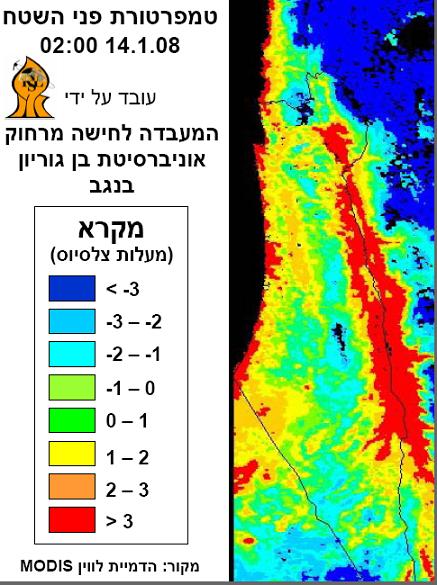Researchers from Ben Gurion University processed the MODIS satellite systems data. The distribution of ground surface temperature can be learned from analysis of satellite images. The photo shows that on the night between January 13 and 14, the temperature in the Galilee, on the back of the mountain, and in the Negev dropped below -3 degrees Celsius. In the east of the Golan, even lower than that

An accurate and eye-catching mapping conducted by the researchers of the Remote Sensing Laboratory of the Blaustein Institute for Desert Research at Ben-Gurion University illustrates the strength of the intense cold that has hit Israel in recent days, one of the hardest the country has known in recent years. As you know, in many areas throughout the country the temperature dropped below zero. The cold took a number of lives and caused damage to agriculture estimated at millions of shekels.
The researchers, Dr. Natalia Panov and Prof. Arnon Karneali, processed the MODIS satellite systems data. The distribution of ground surface temperature can be learned from analysis of satellite images. The photo shows that on the night between January 13 and 14, the temperature in the Galilee, on the back of the mountain, and in the Negev dropped below -3 degrees Celsius. In the east of the Golan, even lower than that.
The MODIS system is placed on two satellites belonging to the American space agency NASA. It has 36 channels in different areas of the electromagnetic spectrum. The thermal channels (pictured) were scanned with a resolution of 1 km. The MODIS system passes over Israel 4 times a day.

14 תגובות
The temperature shown is the temperature of the surface and not the air, therefore in built-up areas the temperature is higher (because during the day the sun's rays warmed up).
to the cool responder
If your words were true, then the entire stretch of beach would be painted red, but, that's not the case.
Gilgamesh - Thank you for supporting me in my difficult times.
with a smile
And have a warm and pleasant weekend
Sabdarmish Yehuda
Forecast for Sunday - tomorrow will be warm and cool, there is also a chance of snow in the north, maybe even light rain in the Judean Desert...
Regarding the question of population density and the influence of the sea:
It seems to me that the two effects mentioned exist.
The sea is indeed a factor that moderates the temperature changes (not always warming, but in a cold period like the one discussed, it does warm).
The population also heats up - whether because of the greenhouse gases, whether because of the processes in which these gases are produced, which are mainly exothermic processes, or because in cold periods it especially tries to warm itself and turns on air conditioners and furnaces.
The background to the debate is also interesting and is related to the fact that humans are more likely to settle along rivers and seashores than in other places - something that makes it difficult to distinguish between the two factors of warming.
To Doron and ask:
In the lower places it is hotter and in the higher places it is colder. A brief explanation is as follows:
This is mainly a result of the fact that the air in the lower places is more compressed.
As the altitude increases, so does the air pressure (which is nothing but "hydrostatic" pressure resulting from the weight of the air above you.
When the hot air rises it reaches areas with lower pressure and then it spreads over a larger volume and as a result its temperature drops. Similarly, as cold air descends it warms as the pressure increases.
Beer Sheva and Arad are seen as red dots on a yellow background, which proves Yehuda's claim
To Doron,
The question is good.
In the next step we will be asked why it is colder on the tops of the mountains; After all, heat has a tendency to go up.
Apparently, the atmosphere has a role in trapping the heat.
Bye.
The Jordan Valley and the Arabah are warmer, it's not clear to me why? The place is lower and the cold has a tendency to descend... so why is it warmer there?
Doron.
"And in addition, note that densely populated areas are warmer, Haifa and Gush Dan and in addition the Gaza Strip and areas of Tire and Sidon."
In my opinion it has nothing to do with population density, except for Tel Aviv which is in the center of Gush Dan and the density there is terrible, so there could be an effect of a degree or two due to direct human factors.
Regarding the areas you mentioned. To remind you, they are all adjacent to the sea and most of them (except for the area of Tire and Sidon) are on the coastal plain, and anyone who has studied a little geography, or whose knowledge of the country is not zero knows that the sea heats the areas adjacent to it, especially if they are flat..
As we know, the sea maintains the most stable temperature on Earth throughout the year, so when it's cold it warms you up perfectly (the Western Europeans will explain to you 8-))
Check the amount of beans people ate that day?
This can affect the results…
The truth is, Shelley went to serve in eastern Lebanon on the Syrian border, so if you say that the Lebanese Wild West is hotter, then you must be speaking from experience.
Thank you for the explanation that "warms the heart"
Sabdarmish Yehuda
In Tire and Sidon it is always hotter
Those who haven't been don't know 🙂
And in addition, note that densely populated areas are warmer, Haifa and Gush Dan and in addition the Gaza Strip and the areas of Tzur and Sidon.
Sabdarmish Yehuda
amateur scientist
in a cold mountain
Near water sources - less cold
senior scientist